
- SAP Community
- Products and Technology
- Technology
- Technology Blogs by Members
- Building a CRUD Application with SAPUI5 and ICF RE...
- Subscribe to RSS Feed
- Mark as New
- Mark as Read
- Bookmark
- Subscribe
- Printer Friendly Page
- Report Inappropriate Content
This is the part 2 of 3 of this blog series. In this part we will see the implementation of the Create, Read, Update, Delete methods.
Click here if you did not read the Part 1.
Table of Contents
Part 1
Prerequisites
Overview
SAPLink Nuggets and Eclipse Project download
References
SAPUI5
SAPLink
SAPLink plugins (SCN Code Exchange)
CL_TREX_JSON_SERIALIZER bug fixes
Extending SAPUI5 JSON Model
Creating the ICF REST Service
Creating the custom handler class
Creating the ICF node
Retrieving the request method and the parameters passed in the URL
Part 2
Implementing the REST Service
Model and DDIC objects
Implementing the Create method (POST HTTP verb)
Implementing the Read method (HTTP GET verb)
Implementing the Update method (PUT HTTP verb)
Implementing the Delete method (DELETE HTTP verb)
Part 3
Creating the User Interface
Creating the project
Setting up the SAPUI5 bootstrap and required libraries
Creating the view components
Creating the BSPs to deploy the application and the SAPUI5 framework.
Implementing the Controller’s methods
Create
Read
Update
Delete
Find
Model and DDIC objects
To keep our code clean and adherent to the SoC (Separation of Concerns) principle, we will use a separated class to persist the changes in our contact list. To avoid deviating too much from the main subject, the creation of the model class and dictionary objects is not presented here. You can download here the nugg file with these objects.
Implementing the Create method (POST HTTP verb)
First of all we need to declare the necessary local types and variables.
METHOD if_http_extension~handle_request.
TYPES: BEGIN OF local_type_response,
success TYPE string,
msg TYPE string,
data TYPE ztt_scnblog2,
END OF local_type_response.
* Objects
DATA: lo_contact TYPE REF TO zcl_scnblog2_contact,
lo_json_serializer TYPE REF TO zcl_json_serializer. " Copy of the standard class CL_TREX_JSON_SERIALIZER
* Internal tables
DATA: lt_contacts TYPE STANDARD TABLE OF ztb_scnblog2.
* Structures
DATA: ls_contact TYPE ztb_scnblog2,
ls_response TYPE local_type_response.
* Variables
DATA: l_rc TYPE i,
l_json TYPE string.
* Variables
DATA: l_verb TYPE string,
l_path_info TYPE string,
l_resource TYPE string,
l_param_1 TYPE string,
l_param_2 TYPE string.
…..
Next we implement the code to handle the POST request method that corresponds to the Create Contact action.
WHEN 'POST'. " C (Create)
CLEAR: ls_contact,
ls_response,
l_rc.
* Retrieve form data
ls_contact-email = server->request->get_form_field('email').
ls_contact-firstname = server->request->get_form_field('firstname').
ls_contact-lastname = server->request->get_form_field('lastname').
* Create an instance of the class to persist the Contact data in the database
CREATE OBJECT lo_contact.
* Create the Contact
CALL METHOD lo_contact->create
EXPORTING
i_s_contact = ls_contact
IMPORTING
e_rc = l_rc.
IF l_rc IS INITIAL.
ls_response-success = 'true'.
ls_response-msg = 'User created successfully!'."hardcoded here intentionally
ELSE.
ls_response-success = 'false'.
ls_response-msg = lo_contact->get_message( ).
ENDIF.
* Return the form data received back to the client
APPEND ls_contact TO ls_response-data.
…...
ENDCASE.
CREATE OBJECT lo_json_serializer
EXPORTING
DATA = ls_response. " Data to be serialized
* Serialize ABAP data to JSON
CALL METHOD lo_json_serializer->serialize.
* Get JSON string
CALL METHOD lo_json_serializer->get_data
RECEIVING
rval = l_json.
* Sets the content type of the response
CALL METHOD server->response->set_header_field( name = 'Content-Type'
value = 'application/json; charset=iso-8859-1' ).
* Returns the results in JSON format
CALL METHOD server->response->set_cdata( data = l_json ).
ENDMETHOD.
Let’s understand what the above code does (only the relevant parts).
- First we retrieve the form data received from the client application using the get_form_field method of the request object.
* Retrieve form data
ls_contact-email = server->request->get_form_field('email').
ls_contact-firstname = server->request->get_form_field('firstname').
ls_contact-lastname = server->request->get_form_field('lastname').
- Next we create an instance of the class zcl_scnblog2_contact that will persist the Contact data in the database and call the create method.
* Create an instance of the class to persist the Contact data in the database
CREATE OBJECT lo_contact.
* Create the Contact
CALL METHOD lo_contact->create
EXPORTING
i_s_contact = ls_contact
IMPORTING
e_rc = l_rc.
- Next we need to handle the result of the action based on the return code (l_rc). Then we set the value of the attributes success and msg accordingly.
IF l_rc IS INITIAL.
ls_response-success = 'true'.
ls_response-msg = 'User created successfully!'."hardcoded here intentionally
ELSE.
ls_response-success = 'false'.
ls_response-msg = lo_contact->get_message( ).
ENDIF.
- The information received is returned back to the client application.
* Return the form data received back to the client
APPEND ls_contact TO ls_response-data.
- Finally the data is serialized in a JSON string.
ENDCASE.
CREATE OBJECT lo_json_serializer
EXPORTING
DATA = ls_response. " Data to be serialized
* Serialize ABAP data to JSON
CALL METHOD lo_json_serializer->serialize.
* Get JSON string
CALL METHOD lo_json_serializer->get_data
RECEIVING
rval = l_json.
- To send the JSON response to the client we need this last code.
* Sets the content type of the response
CALL METHOD server->response->set_header_field( name = 'Content-Type'
value = 'application/json; charset=iso-8859-1' ).
* Returns the results in JSON format
CALL METHOD server->response->set_cdata( data = l_json ).
ENDMETHOD.
Let’s test our first method using the Postman REST client.
Select the POST method and type the URL and the form fields. Be aware of using the correct field names (email, firstname, lastname).

Click the Send button to test the service. The service should return a JSON response with the message “Contact created successfully!”.
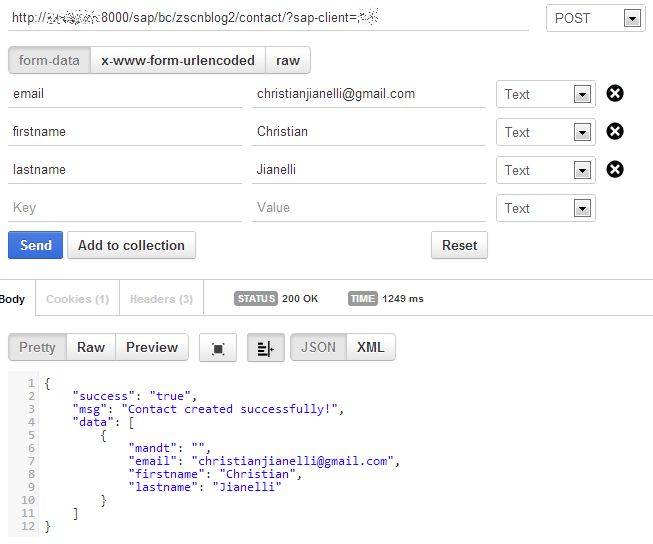
Let’s check the database table using the SE16.
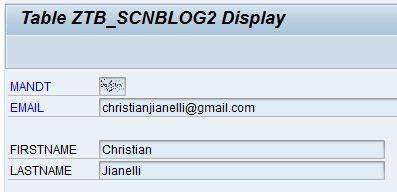
If you hit the send button again without changing the form data the service should return a message informing that the contact already exist.

The created method is finished. Let’s go to the next method, read contact.
Implementing the Read method (HTTP GET verb)
Below is the code that we need to implement to handle the read method. It’s structure is very similar to the create method.
WHEN 'GET'. " R (Read)
CLEAR: ls_contact,
ls_response.
CREATE OBJECT lo_contact.
* Retrieve the Contact's email passed in the URL
ls_contact-email = l_param_1.
* Retrieve querystring data
ls_contact-firstname = server->request->get_form_field('firstname').
ls_contact-lastname = server->request->get_form_field('lastname').
* Read Contact's data
CALL METHOD lo_contact->read
EXPORTING
i_s_contact = ls_contact
IMPORTING
e_t_contacts = lt_contacts.
IF NOT lt_contacts[] IS INITIAL.
ls_response-success = 'true'.
ls_response-data[] = lt_contacts[].
ELSE.
ls_response-success = 'false'.
ls_response-msg = lo_contact->get_message( ).
ENDIF.
Let’s test our read method.
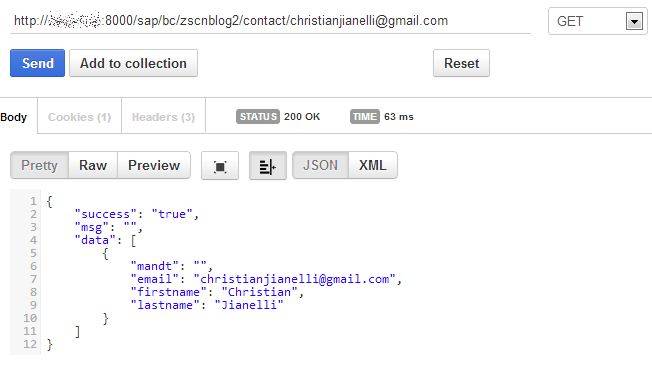
Implementing the Update method (PUT HTTP verb)
Below is the code that we need to implement to handle the update method.
WHEN 'PUT'. " U (Update)
CLEAR: ls_contact,
ls_response,
l_rc.
* Retrieve the Contact's email passed in the URL
ls_contact-email = l_param_1.
* Retrieve form data
ls_contact-firstname = server->request->get_form_field('firstname').
ls_contact-lastname = server->request->get_form_field('lastname').
CREATE OBJECT lo_contact.
* Update the Contact
CALL METHOD lo_contact->update
EXPORTING
i_s_contact = ls_contact
IMPORTING
e_rc = l_rc.
IF l_rc IS INITIAL.
ls_response-success = 'true'.
ls_response-msg = 'Contact updated successfully!'. "Hardcoded here intentionally
ELSE.
ls_response-success = 'false'.
ls_response-msg = lo_contact->get_message( ).
ENDIF.
* Return the form data received to the client
APPEND ls_contact TO ls_response-data.
Let’s test our update method. Let's put an “X” at the end of the contact’s first and last name.
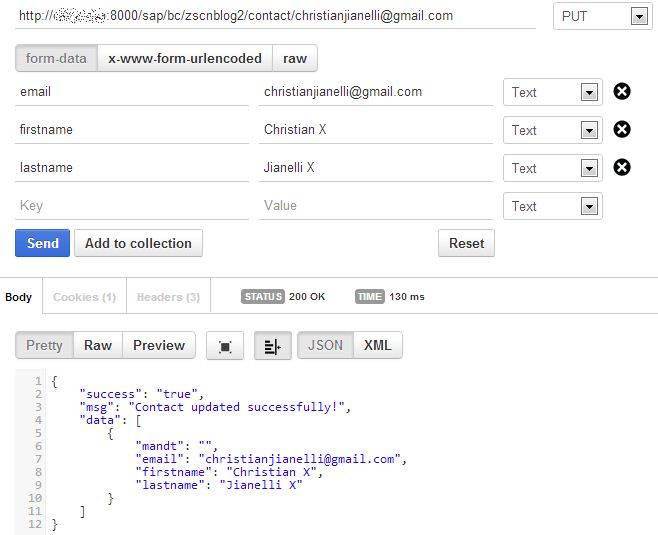
Let’s check our table in the SE16.
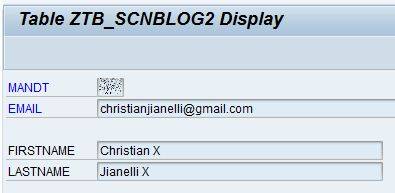
Implementing the Delete method (DELETE HTTP verb)
Below is the code that we need to implement to handle the delete method.
WHEN 'DELETE'. " D (Delete)
CLEAR: ls_contact,
ls_response,
l_rc.
CREATE OBJECT lo_contact.
* Retrieve the Contact's email passed in the URL
ls_contact-email = l_param_1.
* Delete the Contact
CALL METHOD lo_contact->delete
EXPORTING
i_s_contact = ls_contact
IMPORTING
e_rc = l_rc.
IF l_rc IS INITIAL.
ls_response-success = 'true'.
ls_response-msg = 'Contact deleted successfully!'. "Hardcoded here intentionally
ELSE.
ls_response-success = 'false'.
ls_response-msg = lo_contact->get_message( ).
ENDIF.
Let’s test our delete method.
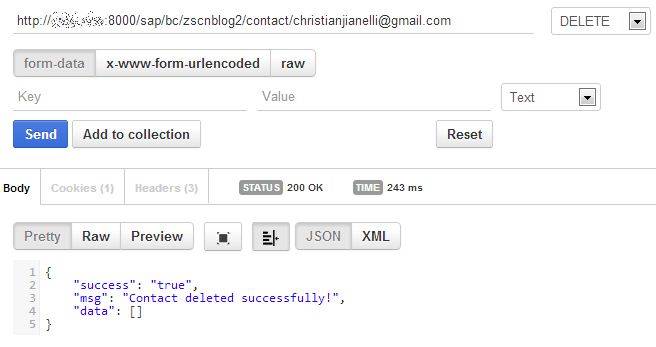
Now our table must be empty. Let’s check it in the SE16.

In the Part 3 of this blog series we will see the most interesting part, the creation of the user interface using SAPUI5.
- SAP Managed Tags:
- SAPUI5,
- SAP Enterprise Portal
You must be a registered user to add a comment. If you've already registered, sign in. Otherwise, register and sign in.
-
"automatische backups"
1 -
"regelmäßige sicherung"
1 -
"TypeScript" "Development" "FeedBack"
1 -
505 Technology Updates 53
1 -
ABAP
14 -
ABAP API
1 -
ABAP CDS Views
2 -
ABAP CDS Views - BW Extraction
1 -
ABAP CDS Views - CDC (Change Data Capture)
1 -
ABAP class
2 -
ABAP Cloud
2 -
ABAP Development
5 -
ABAP in Eclipse
1 -
ABAP Platform Trial
1 -
ABAP Programming
2 -
abap technical
1 -
absl
2 -
access data from SAP Datasphere directly from Snowflake
1 -
Access data from SAP datasphere to Qliksense
1 -
Accrual
1 -
action
1 -
adapter modules
1 -
Addon
1 -
Adobe Document Services
1 -
ADS
1 -
ADS Config
1 -
ADS with ABAP
1 -
ADS with Java
1 -
ADT
2 -
Advance Shipping and Receiving
1 -
Advanced Event Mesh
3 -
AEM
1 -
AI
7 -
AI Launchpad
1 -
AI Projects
1 -
AIML
9 -
Alert in Sap analytical cloud
1 -
Amazon S3
1 -
Analytical Dataset
1 -
Analytical Model
1 -
Analytics
1 -
Analyze Workload Data
1 -
annotations
1 -
API
1 -
API and Integration
3 -
API Call
2 -
Application Architecture
1 -
Application Development
5 -
Application Development for SAP HANA Cloud
3 -
Applications and Business Processes (AP)
1 -
Artificial Intelligence
1 -
Artificial Intelligence (AI)
5 -
Artificial Intelligence (AI) 1 Business Trends 363 Business Trends 8 Digital Transformation with Cloud ERP (DT) 1 Event Information 462 Event Information 15 Expert Insights 114 Expert Insights 76 Life at SAP 418 Life at SAP 1 Product Updates 4
1 -
Artificial Intelligence (AI) blockchain Data & Analytics
1 -
Artificial Intelligence (AI) blockchain Data & Analytics Intelligent Enterprise
1 -
Artificial Intelligence (AI) blockchain Data & Analytics Intelligent Enterprise Oil Gas IoT Exploration Production
1 -
Artificial Intelligence (AI) blockchain Data & Analytics Intelligent Enterprise sustainability responsibility esg social compliance cybersecurity risk
1 -
ASE
1 -
ASR
2 -
ASUG
1 -
Attachments
1 -
Authorisations
1 -
Automating Processes
1 -
Automation
2 -
aws
2 -
Azure
1 -
Azure AI Studio
1 -
B2B Integration
1 -
Backorder Processing
1 -
Backup
1 -
Backup and Recovery
1 -
Backup schedule
1 -
BADI_MATERIAL_CHECK error message
1 -
Bank
1 -
BAS
1 -
basis
2 -
Basis Monitoring & Tcodes with Key notes
2 -
Batch Management
1 -
BDC
1 -
Best Practice
1 -
bitcoin
1 -
Blockchain
3 -
bodl
1 -
BOP in aATP
1 -
BOP Segments
1 -
BOP Strategies
1 -
BOP Variant
1 -
BPC
1 -
BPC LIVE
1 -
BTP
12 -
BTP Destination
2 -
Business AI
1 -
Business and IT Integration
1 -
Business application stu
1 -
Business Application Studio
1 -
Business Architecture
1 -
Business Communication Services
1 -
Business Continuity
1 -
Business Data Fabric
3 -
Business Partner
12 -
Business Partner Master Data
10 -
Business Technology Platform
2 -
Business Trends
4 -
CA
1 -
calculation view
1 -
CAP
3 -
Capgemini
1 -
CAPM
1 -
Catalyst for Efficiency: Revolutionizing SAP Integration Suite with Artificial Intelligence (AI) and
1 -
CCMS
2 -
CDQ
12 -
CDS
2 -
Cental Finance
1 -
Certificates
1 -
CFL
1 -
Change Management
1 -
chatbot
1 -
chatgpt
3 -
CL_SALV_TABLE
2 -
Class Runner
1 -
Classrunner
1 -
Cloud ALM Monitoring
1 -
Cloud ALM Operations
1 -
cloud connector
1 -
Cloud Extensibility
1 -
Cloud Foundry
4 -
Cloud Integration
6 -
Cloud Platform Integration
2 -
cloudalm
1 -
communication
1 -
Compensation Information Management
1 -
Compensation Management
1 -
Compliance
1 -
Compound Employee API
1 -
Configuration
1 -
Connectors
1 -
Consolidation Extension for SAP Analytics Cloud
2 -
Control Indicators.
1 -
Controller-Service-Repository pattern
1 -
Conversion
1 -
Cosine similarity
1 -
cryptocurrency
1 -
CSI
1 -
ctms
1 -
Custom chatbot
3 -
Custom Destination Service
1 -
custom fields
1 -
Customer Experience
1 -
Customer Journey
1 -
Customizing
1 -
cyber security
3 -
cybersecurity
1 -
Data
1 -
Data & Analytics
1 -
Data Aging
1 -
Data Analytics
2 -
Data and Analytics (DA)
1 -
Data Archiving
1 -
Data Back-up
1 -
Data Flow
1 -
Data Governance
5 -
Data Integration
2 -
Data Quality
12 -
Data Quality Management
12 -
Data Synchronization
1 -
data transfer
1 -
Data Unleashed
1 -
Data Value
8 -
database tables
1 -
Datasphere
3 -
datenbanksicherung
1 -
dba cockpit
1 -
dbacockpit
1 -
Debugging
2 -
Delimiting Pay Components
1 -
Delta Integrations
1 -
Destination
3 -
Destination Service
1 -
Developer extensibility
1 -
Developing with SAP Integration Suite
1 -
Devops
1 -
digital transformation
1 -
Documentation
1 -
Dot Product
1 -
DQM
1 -
dump database
1 -
dump transaction
1 -
e-Invoice
1 -
E4H Conversion
1 -
Eclipse ADT ABAP Development Tools
2 -
edoc
1 -
edocument
1 -
ELA
1 -
Embedded Consolidation
1 -
Embedding
1 -
Embeddings
1 -
Employee Central
1 -
Employee Central Payroll
1 -
Employee Central Time Off
1 -
Employee Information
1 -
Employee Rehires
1 -
Enable Now
1 -
Enable now manager
1 -
endpoint
1 -
Enhancement Request
1 -
Enterprise Architecture
1 -
ETL Business Analytics with SAP Signavio
1 -
Euclidean distance
1 -
Event Dates
1 -
Event Driven Architecture
1 -
Event Mesh
2 -
Event Reason
1 -
EventBasedIntegration
1 -
EWM
1 -
EWM Outbound configuration
1 -
EWM-TM-Integration
1 -
Existing Event Changes
1 -
Expand
1 -
Expert
2 -
Expert Insights
2 -
Exploits
1 -
Fiori
14 -
Fiori Elements
2 -
Fiori SAPUI5
12 -
Flask
1 -
Full Stack
8 -
Funds Management
1 -
General
1 -
General Splitter
1 -
Generative AI
1 -
Getting Started
1 -
GitHub
8 -
Grants Management
1 -
groovy
1 -
GTP
1 -
HANA
6 -
HANA Cloud
2 -
Hana Cloud Database Integration
2 -
HANA DB
2 -
HANA XS Advanced
1 -
Historical Events
1 -
home labs
1 -
HowTo
1 -
HR Data Management
1 -
html5
8 -
HTML5 Application
1 -
Identity cards validation
1 -
idm
1 -
Implementation
1 -
input parameter
1 -
instant payments
1 -
Integration
3 -
Integration Advisor
1 -
Integration Architecture
1 -
Integration Center
1 -
Integration Suite
1 -
intelligent enterprise
1 -
iot
1 -
Java
1 -
job
1 -
Job Information Changes
1 -
Job-Related Events
1 -
Job_Event_Information
1 -
joule
4 -
Journal Entries
1 -
Just Ask
1 -
Kerberos for ABAP
8 -
Kerberos for JAVA
8 -
KNN
1 -
Launch Wizard
1 -
Learning Content
2 -
Life at SAP
5 -
lightning
1 -
Linear Regression SAP HANA Cloud
1 -
local tax regulations
1 -
LP
1 -
Machine Learning
2 -
Marketing
1 -
Master Data
3 -
Master Data Management
14 -
Maxdb
2 -
MDG
1 -
MDGM
1 -
MDM
1 -
Message box.
1 -
Messages on RF Device
1 -
Microservices Architecture
1 -
Microsoft Universal Print
1 -
Middleware Solutions
1 -
Migration
5 -
ML Model Development
1 -
Modeling in SAP HANA Cloud
8 -
Monitoring
3 -
MTA
1 -
Multi-Record Scenarios
1 -
Multiple Event Triggers
1 -
Myself Transformation
1 -
Neo
1 -
New Event Creation
1 -
New Feature
1 -
Newcomer
1 -
NodeJS
2 -
ODATA
2 -
OData APIs
1 -
odatav2
1 -
ODATAV4
1 -
ODBC
1 -
ODBC Connection
1 -
Onpremise
1 -
open source
2 -
OpenAI API
1 -
Oracle
1 -
PaPM
1 -
PaPM Dynamic Data Copy through Writer function
1 -
PaPM Remote Call
1 -
PAS-C01
1 -
Pay Component Management
1 -
PGP
1 -
Pickle
1 -
PLANNING ARCHITECTURE
1 -
Popup in Sap analytical cloud
1 -
PostgrSQL
1 -
POSTMAN
1 -
Process Automation
2 -
Product Updates
4 -
PSM
1 -
Public Cloud
1 -
Python
4 -
Qlik
1 -
Qualtrics
1 -
RAP
3 -
RAP BO
2 -
Record Deletion
1 -
Recovery
1 -
recurring payments
1 -
redeply
1 -
Release
1 -
Remote Consumption Model
1 -
Replication Flows
1 -
research
1 -
Resilience
1 -
REST
1 -
REST API
1 -
Retagging Required
1 -
Risk
1 -
Rolling Kernel Switch
1 -
route
1 -
rules
1 -
S4 HANA
1 -
S4 HANA Cloud
1 -
S4 HANA On-Premise
1 -
S4HANA
3 -
S4HANA_OP_2023
2 -
SAC
10 -
SAC PLANNING
9 -
SAP
4 -
SAP ABAP
1 -
SAP Advanced Event Mesh
1 -
SAP AI Core
8 -
SAP AI Launchpad
8 -
SAP Analytic Cloud Compass
1 -
Sap Analytical Cloud
1 -
SAP Analytics Cloud
4 -
SAP Analytics Cloud for Consolidation
3 -
SAP Analytics Cloud Story
1 -
SAP analytics clouds
1 -
SAP BAS
1 -
SAP Basis
6 -
SAP BODS
1 -
SAP BODS certification.
1 -
SAP BTP
21 -
SAP BTP Build Work Zone
2 -
SAP BTP Cloud Foundry
6 -
SAP BTP Costing
1 -
SAP BTP CTMS
1 -
SAP BTP Innovation
1 -
SAP BTP Migration Tool
1 -
SAP BTP SDK IOS
1 -
SAP Build
11 -
SAP Build App
1 -
SAP Build apps
1 -
SAP Build CodeJam
1 -
SAP Build Process Automation
3 -
SAP Build work zone
10 -
SAP Business Objects Platform
1 -
SAP Business Technology
2 -
SAP Business Technology Platform (XP)
1 -
sap bw
1 -
SAP CAP
2 -
SAP CDC
1 -
SAP CDP
1 -
SAP CDS VIEW
1 -
SAP Certification
1 -
SAP Cloud ALM
4 -
SAP Cloud Application Programming Model
1 -
SAP Cloud Integration for Data Services
1 -
SAP cloud platform
8 -
SAP Companion
1 -
SAP CPI
3 -
SAP CPI (Cloud Platform Integration)
2 -
SAP CPI Discover tab
1 -
sap credential store
1 -
SAP Customer Data Cloud
1 -
SAP Customer Data Platform
1 -
SAP Data Intelligence
1 -
SAP Data Migration in Retail Industry
1 -
SAP Data Services
1 -
SAP DATABASE
1 -
SAP Dataspher to Non SAP BI tools
1 -
SAP Datasphere
9 -
SAP DRC
1 -
SAP EWM
1 -
SAP Fiori
2 -
SAP Fiori App Embedding
1 -
Sap Fiori Extension Project Using BAS
1 -
SAP GRC
1 -
SAP HANA
1 -
SAP HCM (Human Capital Management)
1 -
SAP HR Solutions
1 -
SAP IDM
1 -
SAP Integration Suite
9 -
SAP Integrations
4 -
SAP iRPA
2 -
SAP Learning Class
1 -
SAP Learning Hub
1 -
SAP Odata
2 -
SAP on Azure
1 -
SAP PartnerEdge
1 -
sap partners
1 -
SAP Password Reset
1 -
SAP PO Migration
1 -
SAP Prepackaged Content
1 -
SAP Process Automation
2 -
SAP Process Integration
2 -
SAP Process Orchestration
1 -
SAP S4HANA
2 -
SAP S4HANA Cloud
1 -
SAP S4HANA Cloud for Finance
1 -
SAP S4HANA Cloud private edition
1 -
SAP Sandbox
1 -
SAP STMS
1 -
SAP successfactors
3 -
SAP SuccessFactors HXM Core
1 -
SAP Time
1 -
SAP TM
2 -
SAP Trading Partner Management
1 -
SAP UI5
1 -
SAP Upgrade
1 -
SAP Utilities
1 -
SAP-GUI
8 -
SAP_COM_0276
1 -
SAPBTP
1 -
SAPCPI
1 -
SAPEWM
1 -
sapmentors
1 -
saponaws
2 -
SAPS4HANA
1 -
SAPUI5
4 -
schedule
1 -
Script Operator
1 -
Secure Login Client Setup
8 -
security
9 -
Selenium Testing
1 -
Self Transformation
1 -
Self-Transformation
1 -
SEN
1 -
SEN Manager
1 -
service
1 -
SET_CELL_TYPE
1 -
SET_CELL_TYPE_COLUMN
1 -
SFTP scenario
2 -
Simplex
1 -
Single Sign On
8 -
Singlesource
1 -
SKLearn
1 -
soap
1 -
Software Development
1 -
SOLMAN
1 -
solman 7.2
2 -
Solution Manager
3 -
sp_dumpdb
1 -
sp_dumptrans
1 -
SQL
1 -
sql script
1 -
SSL
8 -
SSO
8 -
Substring function
1 -
SuccessFactors
1 -
SuccessFactors Platform
1 -
SuccessFactors Time Tracking
1 -
Sybase
1 -
system copy method
1 -
System owner
1 -
Table splitting
1 -
Tax Integration
1 -
Technical article
1 -
Technical articles
1 -
Technology Updates
14 -
Technology Updates
1 -
Technology_Updates
1 -
terraform
1 -
Threats
2 -
Time Collectors
1 -
Time Off
2 -
Time Sheet
1 -
Time Sheet SAP SuccessFactors Time Tracking
1 -
Tips and tricks
2 -
toggle button
1 -
Tools
1 -
Trainings & Certifications
1 -
Transformation Flow
1 -
Transport in SAP BODS
1 -
Transport Management
1 -
TypeScript
2 -
ui designer
1 -
unbind
1 -
Unified Customer Profile
1 -
UPB
1 -
Use of Parameters for Data Copy in PaPM
1 -
User Unlock
1 -
VA02
1 -
Validations
1 -
Vector Database
2 -
Vector Engine
1 -
Visual Studio Code
1 -
VSCode
1 -
Vulnerabilities
1 -
Web SDK
1 -
work zone
1 -
workload
1 -
xsa
1 -
XSA Refresh
1
- « Previous
- Next »
- Consuming SAP with SAP Build Apps - Mobile Apps for iOS and Android in Technology Blogs by SAP
- How to use AI services to translate Picklists in SAP SuccessFactors - An example in Technology Blogs by SAP
- Accelerate Business Process Development with SAP Build Process Automation Pre-Built Content in Technology Blogs by SAP
- New Machine Learning features in SAP HANA Cloud in Technology Blogs by SAP
- Kyma Integration with SAP Cloud Logging. Part 2: Let's ship some traces in Technology Blogs by SAP
| User | Count |
|---|---|
| 5 | |
| 5 | |
| 5 | |
| 4 | |
| 4 | |
| 4 | |
| 4 | |
| 4 | |
| 3 | |
| 3 |